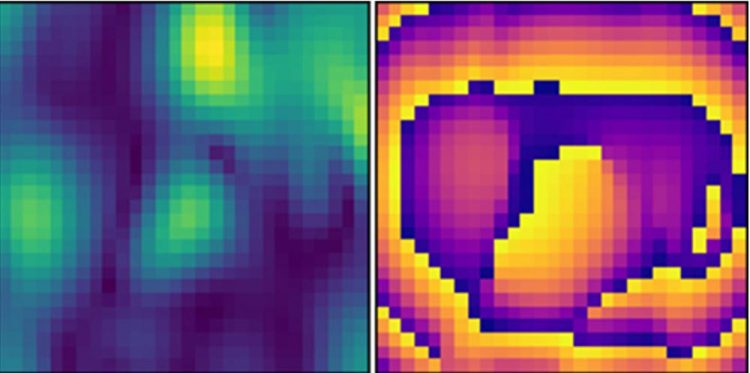Machine learning shapes microwaves for a computer's eyes

An example of a wave pattern (right) and its intensity levels (left) developed by the machine learning algorithm to best illuminate the most important features of an object being identified. Credit: Mohammadreza Imani, Duke University
Engineers from Duke University and the Institut de Physique de Nice in France have developed a new method to identify objects using microwaves that improves accuracy while reducing the associated computing time and power requirements.
The system could provide a boost to object identification and speed in fields where both are critical, such as autonomous vehicles, security screening and motion sensing.
The new machine-learning approach cuts out the middleman, skipping the step of creating an image for analysis by a human and instead analyzes the pure data directly. It also jointly determines optimal hardware settings that reveal the most important data while simultaneously discovering what the most important data actually is.
In a proof-of-principle study, the setup correctly identified a set of 3D numbers using tens of measurements instead of the hundreds or thousands typically required.
The results appear online on December 6 in the journal Advanced Science and are a collaboration between David R. Smith, the James B. Duke Distinguished Professor of Electrical and Computer Engineering at Duke, and Roarke Horstmeyer, assistant professor of biomedical engineering at Duke.
“Object identification schemes typically take measurements and go to all this trouble to make an image for people to look at and appreciate,” said Horstmeyer. “But that's inefficient because the computer doesn't need to 'look' at an image at all.”
“This approach circumvents that step and allows the program to capture details that an image-forming process might miss while ignoring other details of the scene that it doesn't need,” added Aaron Diebold, a research assistant in Smith's lab. “We're basically trying to see the object directly from the eyes of the machine.”
In the study, the researchers use a metamaterial antenna that can sculpt a microwave wave front into many different shapes. In this case, the metamaterial is an 8×8 grid of squares, each of which contains electronic structures that allow it to be dynamically tuned to either block or transmit microwaves.
For each measurement, the intelligent sensor selects a handful of squares to let microwaves pass through. This creates a unique microwave pattern, which bounces off the object to be recognized and returns to another similar metamaterial antenna. The sensing antenna also uses a pattern of active squares to add further options to shape the reflected waves. The computer then analyzes the incoming signal and attempts to identify the object.
By repeating this process thousands of times for different variations, the machine learning algorithm eventually discovers which pieces of information are the most important as well as which settings on both the sending and receiving antennas are the best at gathering them.
“The transmitter and receiver act together and are designed together by the machine learning algorithm,” said Mohammadreza Imani, research assistant in Smith's lab. “They are jointly designed and optimized to capture the features relevant to the task at hand.”
“If you know your task, and you know what sort of scene to expect, you may not need to capture all the information possible,” said Philipp del Hougne, a postdoctoral fellow at the Institut de Physique de Nice. “This co-design of measurement and processing allows us to make use of all the a priori knowledge that we have about the task, scene and measurement constraints to optimize the entire sensing process.”
After training, the machine learning algorithm landed on a small group of settings that could help it separate the data's wheat from the chaff, cutting down on the number of measurements, time and computational power it needs. Instead of the hundreds or even thousands of measurements typically required by traditional microwave imaging systems, it could see the object in less than 10 measurements.
Whether or not this level of improvement would scale up to more complicated sensing applications is an open question. But the researchers are already trying to use their new concept to optimize hand-motion and gesture recognition for next-generation computer interfaces. There are plenty of other domains where improvements in microwave sensing are needed, and the small size, low cost and easy manufacturability of these types of metamaterials make them promising candidates for future devices.
“Microwaves are ideal for applications like concealed threat detection, identifying objects on the road for driverless cars or monitoring for emergencies in assisted-living facilities,” said del Hougne. “When you think about all of these applications, you need the sensing to be as quick as possible, so we hope our approach will prove useful in making these ideas reliable realities.”
###
This research was supported by the Air Force Office of Scientific Research (FA9550-18-1-0187).
CITATION: “Learned Integrated Sensing Pipeline: Reconfigurable Metasurface Transceivers as Trainable Physical Layer in an Artificial Neural Network.” Philipp del Hougne, Mohammadreza F. Imani, Aaron V. Diebold, Roarke Horstmeyer, and David R. Smith. Adv. Sci. 2019, 1901913. DOI: 10.1002/advs.201901913
Media Contact
All latest news from the category: Information Technology
Here you can find a summary of innovations in the fields of information and data processing and up-to-date developments on IT equipment and hardware.
This area covers topics such as IT services, IT architectures, IT management and telecommunications.
Newest articles

NASA: Mystery of life’s handedness deepens
The mystery of why life uses molecules with specific orientations has deepened with a NASA-funded discovery that RNA — a key molecule thought to have potentially held the instructions for…

What are the effects of historic lithium mining on water quality?
Study reveals low levels of common contaminants but high levels of other elements in waters associated with an abandoned lithium mine. Lithium ore and mining waste from a historic lithium…

Quantum-inspired design boosts efficiency of heat-to-electricity conversion
Rice engineers take unconventional route to improving thermophotovoltaic systems. Researchers at Rice University have found a new way to improve a key element of thermophotovoltaic (TPV) systems, which convert heat…



